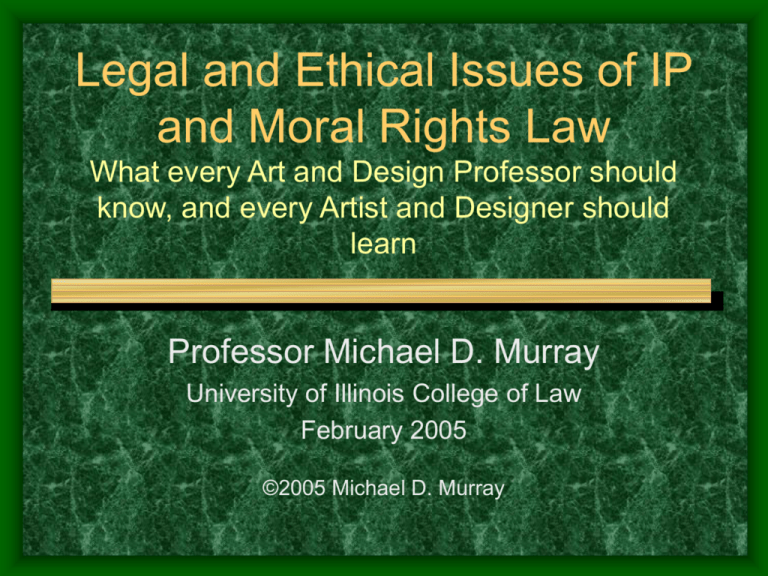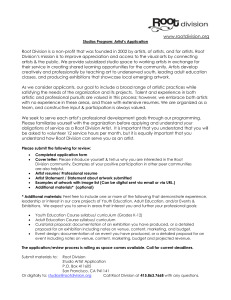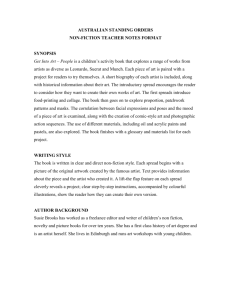
Legal and Ethical Issues of IP
and Moral Rights Law
What every Art and Design Professor should
know, and every Artist and Designer should
learn
Professor Michael D. Murray
University of Illinois College of Law
February 2005
©2005 Michael D. Murray
Art Law
• Intellectual Property Law
• First Amendment Law
• Artist’s Business Relationships
• International Law
Intellectual Property Law
• Copyright
• Trademark
• Moral Rights and Economic Rights
• Right of Publicity
Copyright
How do you get one?
• Create something
• No formal requirements (except to sue
and for certain damages)
• Copyright attaches as soon as a
concept is put into a tangible medium
Idea vs. Expression
• Ideas - not copyrightable
• The expression and embodiment of an
idea can be copyrighted
• Copying an idea?
• Works that embody the same idea?
Idea vs. Expression Means
• Themes
• Historical events
• Research
• “Facts”
• Raw data
Creativity and Originality
• some creative or original element
• “Slavish” copy?
• Sweat equity?
• New editions, new compilations,
derivative works?
• Creative?
• What elements
does the
photographer
bring?
Snap Shots
• Creative?
• Cartier-Bresson
– Father of
Modern Snapshooting
photography
Problems
• Digital Photography?
• Photocopies?
• Clip art?
Problem: Creative and original?
Clip art by itself
Clip art rearranged
Standard of Originality
• Very low standard
• Not uniqueness or one of a kind status
• Random independent creation
Problem?
How thick is your copyright?
• Unprotectable elements
• Scenes à Faire
• Derivative works
• THIN copyright
Doll Faces
• Mattel, Inc. v. Goldberger Doll Mfg. Co.
• Total look and feel
• Satava v. Lowry
• Subtraction of unprotectable elements
Derivative Works
• Substantially
different from
original
• Copied
elements not
copyrightable
a second time
Fixed and Tangible Medium
• Written, recorded in media
• –Speeches, lectures, discussions, or
choreography?
• –Performance of a play or other live
event?
• –Improvised music?
Esquire Lamp
Esquire, Inc. v. Ringer
• Industrial design
• Separate or separable artistic features
Policies behind Utilitarian Rule
• competition and progress in useful
articles
– No monopoly
– Patent law
• art is supposed to be ornamental
Decorative lamps
Silk Objects
Jewelry Art
Effect of 1976 Act
• Pre-1976 Act, copyright sold with work
• Under the 1976 Act, presumption reversed
copyright does not transfer unless the
contract of sale says it does
Protected Rights
17 USC §106
• Right to copy
• Right to make derivative works
• Other rights – to display, distribute, stage
or perform, or broadcast the works
Infringement Elements
• Copyrighted and registered work
• Access to the work
• Prohibited use of a “substantial
and material” portion of the work
• Evidence of actual copying, or
• Substantial Similarity
Element 3 – Prohibited Use
• Non-Fair Use use
• of a “substantial and material”
portion of the work
• Substantial and material means more
than trivial, more than de minimis
Actual Copying – the legacy of
Jeff Koons
• Rogers v. Koons
– String of Puppies
• United Features Synd. v.
Koons
– Odie the Dog from
Garfield
• Campbell v. Koons
– Boys with Pig photo
Rogers v. Koons
Substantial and Material
Portion
• Not necessarily the whole work
• More than trivial
• But you could have stolen more?
Derivative Works
• Work based upon one or more
preexisting works
• In any other form in which a work
may be recast, transformed, or
adapted
Potency of Derivative Work
Standard
• Must it incorporate most of the
original work?
• The “heart” of the work?
• A portion of the copyrighted work
in some form
How Big a Portion?
• Campbell v. Rose Acuff – opening
lines and bass riff
• Harper & Row v. Nation Enters. – 400
words
• Los Angeles News Service v. Reuters
– a few seconds
De Minimis Use
• Amount used
• Time of exposure
• Prominence
• Ringgold v. Black Entertainment Television
(1997)
• Incidental use
• 27 seconds of air time – a few seconds at a time
• No full shot
“Made in America”
• Jackson v. Warner Bros.
Leicester v. Warner Bros.
• Batman Forever
• Architectural features
Substantial Similarity
Two tests for substantial similarity:
• Extrinsic Similarity
• Intrinsic Similarity
Saul
Steinberg
• New Yorker
Magazine
• New Yorker’s
View of the
World
Steinberg
• Spe
Problem?
Fair Use 17 USC §107
• Purpose of Use
• Nature of Copyrighted Work
• Amount taken
• Effect on market for the original
Fair Uses
• Education
• Comment and criticism
• News Reporting
Fair Use
• Factors are balanced
• No factor is key
• Bad score on one can be balanced by
extremely high score on another
• Case by case determination
Examples: Education
• Simple copying of limited portions for
display in class
• Copying of entire chapters
• Copying of entire work (articles, books)
• Copying and displaying, publishing,
distributing further – on web, in
casebooks
Examples: Comment, Critique
• Illustration of comment or criticism
• Not the highlights of the work
• Harper & Row v. Nation Enterprises:
• Reproducing the the heart of the work?
• Bad motive?
Parody – the Granddaddy of Fair Use
Exceptions
•
•
•
•
•
•
When you got it, you got it
Allows commercial uses
Famous works
Same medium
Take vast amounts
No dilution
Parodic Purpose
• ONE purpose is to make fun of the original
• Apparent from the work itself
• Sole purpose?
• Main purpose?
• The nature of the original work matters
Transformative Requirement
• Must transform the original into a new
creation
• BUT the viewer must be able to discern
two works by two different artists
• If viewer would think the original artist
reprised or updated her own work, you
fail
Dr. Suess Enters. v. Penguin Books
Steinberg
• Spe
Leibovitz v. Paramount
Walt Disney v. Air
Pirates
• Utilit
Columbia Pictures v. Miramax
•I
Copyright Ethics
• Don’t copy works
• Copy ideas
• 70 years after death of artist = public
domain
• Be careful about fair uses
• Satire is not parody
Trademark
Trademark Concepts
• Consumer protection
• Commerce, use in commerce
• Statutory, not from Constitution
Trademark Concepts
• Trademarks can be forever
• Marks can become incontestable
False Designation of Origin
• Trademark vs. Copyright and Patents
• “Origin” means source of goods
• Cannot wrap new IP protection over public
domain works through trademark
Infringement - Elements
• Likelihood of confusion
• by reasonably prudent buyer
• class of goods may affect the
standard
Likelihood of Confusion
• Proof of actual confusion?
• Exact similitude?
• General confusion
• Reverse confusion
Fair Uses
• Nominative Fair Use (Classic Fair Use)
• Comparative use
• News reporting
• Parodies and other forms of comment and
criticism
• But include ® or ™ symbol
Trademark Parody – “Thin Ice”
• Shooting the King
• Conger up, but be transformative
• Commercial/Non-commercial usage
remains important
• Dilution makes things riskier
Parodies
• Targeting the original and what it stands
for
• Borrowing a trademark to make
generalized point of comment or satire of
society?
• Ridiculous parodies of “serious”
companies (but watch for dilution)
Anheuser Busch
v. Balducci
Kraft Foods and
King VelVeeda
Cliffs Notes v. Bantam
Barbie Battles
Mattel v. MCA
Records
• Aqua lyrics:
I’m a Barbie Girl, in
a Barbie world; life
is plastic; it’s
fantastic . . . You can
brush my hair,
undress me
everywhere . . . I’m a
blond bimbo girl, in
a fantasy world . . .
Tarkay vs. Patricia Govezensky
P
A
T
R
I
C
I
A
P
A
T
R
I
C
I
A
Trade Dress and Artistic Style
• Romm Art Creations Ltd. v. Simcha Int’l Arts,
Inc. (E.D.N.Y. 1992) – held that an artist’s style
of painting could be protected as trade dress
• Style only need create “same overall
impression” to be sufficiently similar to infringe
• Potentially damaging to traditional notions of art
training, progress and development of artistic
style, and the concept of “schools of art.”
Trademark Ethics
• Commercial v. non-commercial
• Parody and fair use more difficult
• Use the ® or ™ symbol
Moral Rights
Les Droits Moreaux - Overview
• Right to Create or not to create
• Right of Attribution (or Paternity)
• Right of Respect (to Determine
Completeness)
• Right to Disclose or Withdraw from
Display
• Right of Integrity
Moral Rights
•
•
•
•
personal right
arise from the artist’s personality
affect the persona of the artist
are not transferable (but may
descend to heirs)
• In strictest regimes, they are
inalienable
Moral Rights – Public Policy –
Artist orientation
• To protect an artist’s reputation and
encourage artists to create more art
• To protect the art works themselves –
they have part of the personality of the
artist poured into them
Moral Rights – Public Policy –
Cultural Property orientation
• To protect the integrity of art in the
nation – the record of achievement of the
country’s artists
• To protect and preserve the national
cultural identity – cultural property of
the nation – for educational and
enrichment purposes
Public Policy – French vs. USA
• French
• USA (pre-VARA)
• Protects attributes lent • Protects economic
rights (author’s
to work by the artist
rights)
• Protects culture
• Does not protect
• Doubly encourages
works from
artists to create
destruction
• Artists can jerk around
•
Encourages
creation
clients and others
• Contract law limits
artists’ rights to jerk
around clients and
others
Respect & Completeness –
The Right Not to Create (Europe)
• Artists have the right to determine
when they will produce art
• Lack of inspiration?
The Right to Create (Europe)
• Artists may compel completion
• Patrons have no corresponding right to
call it quits or to order completion
Brown & Gold: Portrait of Lady Eden
by James McNeill Whistler, 1894
America – no right not to create
• National Historic Shrines v. Dali (1967)
• fund-raising stunt
• contract law grounds
• still no forced servitude
• expectancy damages – not simply out of
pocket costs
Completeness–an American in Paris?
• Carco c. Camoin (1931) – sliced and
diced
• Stella v. Mazoh (1982)
• Someone left the art out in the rain . . .
Attribution (Paternity)
• France – recognized
• USA – Not unless written
into contract
• Vargas v. Esquire (7th Cir.
1947)
The Right of Integrity
• Cropped, fragmented, or rearranged
work
• Prevent destruction of work
• Mandate destruction of altered or
damaged work?
Right of Integrity – Comparison
• Bernard Buffet’s
refrigerator (France)
• Calder’s Pittsburgh
Mobile (USA)
John Huston – Colorization
• John Huston’s
“Asphalt Jungle”
(in France)
Site specific work
Serra’s
“Tilted Arc”
Cor-Ten steel
120ft long, 12ft high
Moral Rights for the USA?
The Visual Artists Rights Act of 1990
(VARA)
Visual Artists Rights Act (VARA)
• According to 17 U.S.C. § 101: A "work of visual art" is:
• (1) a painting, drawing, print,
• or sculpture, existing in a single copy, in a limited
edition of 200 copies or fewer that are signed
and consecutively numbered by the author, or
• (2) a still photographic image produced for
exhibition purposes only, existing in a single
copy that is signed by the author, or in a limited
edition of 200 copies or fewer that are signed
and consecutively numbered by the author.
VARA – Does not include
• Section 101 - A work of visual art does not
include• (A)(i) any poster, map, globe, chart, technical drawing,
diagram, model, applied art, motion picture or other
audiovisual work, book, magazine, newspaper,
periodical, data base, electronic information service,
electronic publication, or similar publication;
• (ii) any merchandising item or advertising,
promotional, descriptive, covering, or packaging
material or container;
• (B) any work made for hire; or
• (C) any work not subject to copyright protection under
this title.
VARA’s Moral Rights
17 USC § 106A
• Right of Attribution (Paternity)
• Right of Integrity (distortion, mutilation,
modification) –
• If prejudicial to artist’s honor or
reputation
• If work of “recognized stature”
Work of Recognized Stature
• Martin – won a local art contest; some
mention in art review magazines =
recognized stature (note: work had
already been destroyed at time of suit)
• Carter – experts poured over the
partially completed work and declared it
not to be of recognized stature
Non-Visual Art
• Chesler v. Avon Book Div.
• Ohio Players, George Benson
The End
© 2005 Michael D. Murray
All Rights Reserved








